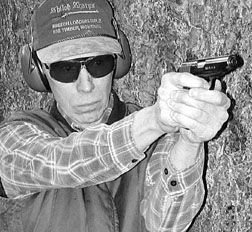
No matter the reasons, many people cling to the idea of a pocket pistol as being somehow useful. Those with more experience will generally arm themselves in a more powerful, if not more convenient, manner, but as someone once said, rule number one for gunfighting is, “Have a gun.” The pocket pistol is often there in the pocket or purse while the bigger, heavier gun stays home. Of course pocket pistols can be, and commonly are, carried in some sort of holster. But some spend most of their lives being dragged around in the dusty confines of a makeshift container.
The so-called pocket pistol comes in many sizes and calibers. Not all of them are actually suitable for the pocket or for actual self-defense, come to think of it, but they can surely be fun guns, ammo costs notwithstanding. Our selection here consists of two surplus (used) semi-autos in .32 ACP caliber, and one in 9×18 Makarov. We thought this match-up would bear some close examination.
We selected a fine Walther PP in .32 (about $325), and two close copies of it, the VZOR 70 from Czechoslovakia (about $125), and a Makarov in a larger caliber, 9×18 (about $150). All were double action, all blued, and all had plastic stocks and fixed sights. They all had safeties that dropped their hammers, and while one of them could be carried cocked and locked, it made little sense. Two of them had almost-acceptable double-action pulls, and the single-action (second-shot) triggers were all not bad. All three guns were well preserved, and all about thirty years old. Here’s what we found:
[PDFCAP(1)]
This German-made Walther had the most apparent care in its fit and finish. The metal polish and bluing were excellent. Before we fired any of the guns we thought the Walther PP felt the best in the shooting hand. It had excellent sights, both with central white dots. The front was a square-top post, beautifully milled as part of the slide. The eye was led to it via a wavy-serrated raised rib that cut glare significantly. The square-notched rear was dovetailed securely into the rib and offered driftable windage, which was not required, as we found out. In fact, all three guns shot central, though the CZ and Makarov printed somewhat high.
The hammer was well serrated for easy control. The checkered plastic grip panels gave acceptable control to the gun, though we later found the gun slipped in our hand when firing hotter loads. The ejection port was large, the biggest of the three guns. The small, beautifully finished extractor worked well to sling the empties positively out of the gun. The gun came with two eight-shot magazines, one with an extension that gave a pinkie rest, but didn’t really give a better grasp to the gun. Most of our grip, we found, came from the middle two fingers, and the little finger either rested in place lightly on the magazine extension, or curled gently beneath the other mag. The mags came out and went in easily, and stayed in place. Except for that plastic grip extension, all the parts and pieces of this Walther were made of steel.
The safety worked easily by the firing-hand thumb. Disconcerting when first encountered, the hammer-drop feature of the safety was well thought out. We preferred to ride the hammer forward with the thumb of our weak hand as we used the safety to drop the hammer, rather than letting it fly forward. A simple test is advisable with any gun having a hammer-drop safety. Put a dowel into the barrel of the unloaded, cocked gun with it pointing at the ceiling. Then drop the hammer using the safety. The dowel must not move. If it flies out, you’ve got a dangerous situation in that the gun will fire when the “safety” is activated. All three guns passed this test.
To take the Walther down, the shooter first clears the gun and removes the magazine, then tugs downward on the trigger guard and pushes it to the side to keep it open. Then the slide is withdrawn fully, lifted slightly and eased forward off the front of the barrel. We’ll get to that trigger guard again shortly. Inside, the visible parts were all well made, with outstanding metal work apparent everywhere.
[PDFCAP(2)]
We put the gun together and took it to the range. We found the PP worked perfectly with everything, but the owner will have to spend a bit of time finding the ammo that gives the best accuracy. We got our best groups with Federal Premium Hydra-Shok 65-grain JHP fodder. Best group was 1.4 inches, five shots at 15 yards. American Eagle was about as good, but the Cor-Bon 60-grain JHP was distinctly less accurate here. Groups opened up an inch or so more, though reliability was perfect.
The Cor-Bon loads stung the hand noticeably, and that hinged trigger guard banged the heck out of our supporting-hand fingers, until we applied a strong Ayoob wedge. This put the supporting hand’s index finger firmly beneath the guard, and finger banging was greatly reduced. This banging didn’t happen when firing Cor-Bon in the other .32 ACP pistol, the CZ. The CZ was a lot more comfortable, though the weights of the two pistols were essentially the same. The hammer of the Walther — or any of these guns — could bite some hands, so be careful to take the sort of grip that will keep the web of your hand from getting pinched.
The Walther’s double-action pull was acceptable, but far poorer than a good S&W revolver. The break was far over our Lyman digital meter’s maximum scale of 12 pounds. We guessed it to be in excess of 15 pounds. This is essentially useless in practice, never mind the skills of James Bond. Serious shooting schools teach you to shoot two shots (or more) at the start of an engagement, and it would be difficult to hit anything at reasonable distance with any of this trio of guns with the first double-action shot. Be that as it may, the Walther’s double-action pull was not as good as the Makarov’s, which was long and smooth — but still too heavy. The CZ’s DA pull was just plain awful, and that’s all we’ll say about DA pulls. The PP’s single-action pull was okay, breaking with some creep at 5.2 pounds.
[PDFCAP(3)]
This gun looked much like the Walther, and its fit and finish were quite good. However, a side-by-side examination of the two will quickly show the differences. The CZ had more weight up forward in its slide, and a vastly different contour to its back strap, which was actually formed by the plastic grips. (The PP’s back strap was steel. The smaller Walther PPK had its rear grip formed by plastic panels.) The CZ’s grip felt square, and until we fired the gun we didn’t much care for it. On the range, we found the CZ to be an extremely comfortable gun to fire, with all ammo tried. With its grip shape the firing hand doesn’t really touch the sides of the grip, just the front and back. That means the odd “checkering” didn’t matter, except for looks.
Like the PP, this CZ had the front sight milled as part of the slide. The front blade was too thin, and had a rounded rear contour. That would help it come easily out of your pocket or a holster, but didn’t do a whole lot for the sight picture. We found the sight picture adequate if not ideal. The U-shaped rear notch was driftable for windage. The slide top was serrated to cut glare, but this was not as well done as on the Walther. We got a holster and two magazines, both with extensions, with the CZ. The mags required a strong poke on the release button to get ‘em out of the gun. The button was high on the left side of the frame, as on the Walther. But we could not release the magazines with our firing-hand thumb, unlike with the Walther. These magazines held nine rounds, but we could not insert the magazine with nine in it, so called them eight-round mags. The CZ’s safety was mounted on the left side of the frame, not the slide as with the PP.
The roomy trigger guard was a fixed part of the frame. Takedown was accomplished by pressing a button on the right side of the frame in front of the trigger guard, using the trigger finger. Pulling back on the slide and lifting got the slide free from the frame, much the same as on the Walther. Inside we saw similar design elements, but some of the visible parts were of bent (thick) sheet metal instead of the all-milled parts of the Walther. Both guns had barrels pinned into fixed abutments on the frame, and both had slide springs encircling the barrels. Workmanship on the CZ was pretty good, we thought, but nowhere near as nice as on the Walther. We had slight trouble and one pinched finger reassembling the slide to the frame, but once we found out how to do it, had no further problems.
We noted the bullet transition up the ramp from the frame to the chamber on the CZ was an unbroken ramp. On the Walther it was interrupted, though both guns worked perfectly. One further item of note was the three-position safety on the CZ, which permitted loading the chamber with the safety in the middle position, which didn’t permit firing. With the Makarov, the safety also locked the slide, so it was impossible to chamber a round unless the safety was in the fire position. With the Walther, a round could be chambered with the safety on, but the hammer followed the slide down.
The CZ’s ejection port was large enough, and the extractor was several times larger than that of the PP. On the range this gun worked perfectly, and as noted, handled the hot loads more comfortably than the Walther. It also shot them into smaller groups. Our best was 0.7 inches for five shots of the hot Cor-Bon fodder. One group with Eagle landed four shots into 1.5 inches, but a flier spoiled it. Accuracy with the Federal fodder split the difference. The working (single-action) trigger pull was distinctly double-stage, the break coming at 5.7 pounds.
[PDFCAP(4)]
This Bulgarian-made pistol came with a holster and one magazine, and a cleaning rod of sorts was stowed in the holster. Fit and finish of the Makarov were okay, nothing to rave about but certainly not disgusting. The plastic grips were probably the best grips of this trio, though for right-handers only. There was a thumb rest for the right-hand thumb, and the grip material was modern-looking, gently stippled, and very attractive. The one-piece plastic grip was made in Germany. This gun was nearly as natural-feeling in the hand as the Walther. The front grip strap was long enough that those with narrow to normal hands could get three fingers onto the front grip strap. Some of us were crowded by the magazine lip, which had an uncomfortable sharp edge.
A spring clip mounted on the bottom of the grip retained the magazine, which gave this gun the easiest magazine release, though it required two hands. We actually liked this magazine release the best of the three guns tested.
The metal polish overall was fairly good, way better than war expedient. The overall configuration of this pistol was very like that of the Walther, though with this gun the frame extended forward farther beneath the Walther-shaped slide. The top of the slide had a narrow, serrated rib and the same sight setup as on the other two, the rear sight being drift adjustable and the front milled into the steel of the slide. The sight picture was excellent, with a flat-backed front blade that could have been wider, but was okay, and a square-notched rear that had enough room to easily find the front blade.
Wonder of wonders, there was a slide-release button on the left side of the frame, which made reloading faster than with either of the other two. Reloads could be accomplished by slamming in a full magazine and hitting the button. The other two required you to pull back and release the slide to chamber a fresh round.
Takedown was identical to that of the Walther. The trigger guard was pulled down and pushed to the side, and the slide could then be withdrawn and taken off forward. The guts of the Mak were not all that pretty, but seemed to be well made, sound and solid. As we found, all the parts worked well. One thing we noted was that our particular brand of test ammo left lots of gritty unburned or partially burned powder inside the gun (not in the barrel) that would require careful monitoring in long shooting sessions.
[PDFCAP(5)]
The gun was blocky, and a tad heavier than the other two, but of course it made larger holes in the paper. We had only one type of ammo on hand, Russian-made 115-grain jacketed hollow point. On the range the Makarov handled this ammo reliably. Despite the tiny ejection port our test gun functioned perfectly with all rounds fired. Accuracy was fair, about three inches on average for five shots at 15 yards. As for tinkering to improve accuracy, we’re in the dark here. The slide-to-frame fit seemed snug, and the barrel was securely pinned into the buttress on the frame. (The barrel was inserted into the frame protrusion from the back and, like the others, held with a single cross pin.) Bullets seemed well sized to the barrel. Grooves measured .366/.367, and bullets measured about .367. Is three inches enough accuracy? Probably. Would we like more? Yep.
The trigger didn’t help accuracy, though in fairness, all three guns had triggers that were comfortable to the trigger finger and didn’t feel anywhere as near as heavy as they measured. The Mak had a spongy, creepy SA trigger that broke at 7.6 pounds.
Gun Tests Recommends
Walther PP, $325. Buy It. One of the biggest draws to the Walther is its collectible value, i.e., continued strong and increasing value over time. The PP had an aura that the other guns didn’t, and that will make a big difference to some shooters. We felt the quality of the piece spoke for itself, and felt the Walther PP was worth its cost. It was obviously a fine weapon, and we liked it, most particularly with the standard fodder or Federal’s 65-grain Hydra-Shok. We don’t believe in gun magic, so if you really want an effective self-defense weapon, some of us believe there are better choices than any .32 ACP, though the Walther was one of the best of these we’ve seen.
CZ VZOR 70, $125. Buy It. Overall we thought this CZ VZOR was an excellent gun, particularly in light of its modest price compared to the Walther PP. It was, we thought, an excellent .32 ACP with all that cartridge’s benefits and limitations, but remember that this is not a Walther, and won’t bring the price of the Walther any time in the future. However, we were very pleased with this pistol, and could probably overlook its horrid double-action pull. Although the CZ could be carried cocked and locked, getting the safety off was nearly impossible with the shooting hand, so we were left with the hammer down and a DA first shot.
Makarov 9×18, about $150. Our Pick. The Mak was comfortable, though it had more whack to the hand than the .32s. It would be the best defense weapon of this trio because of that.




























